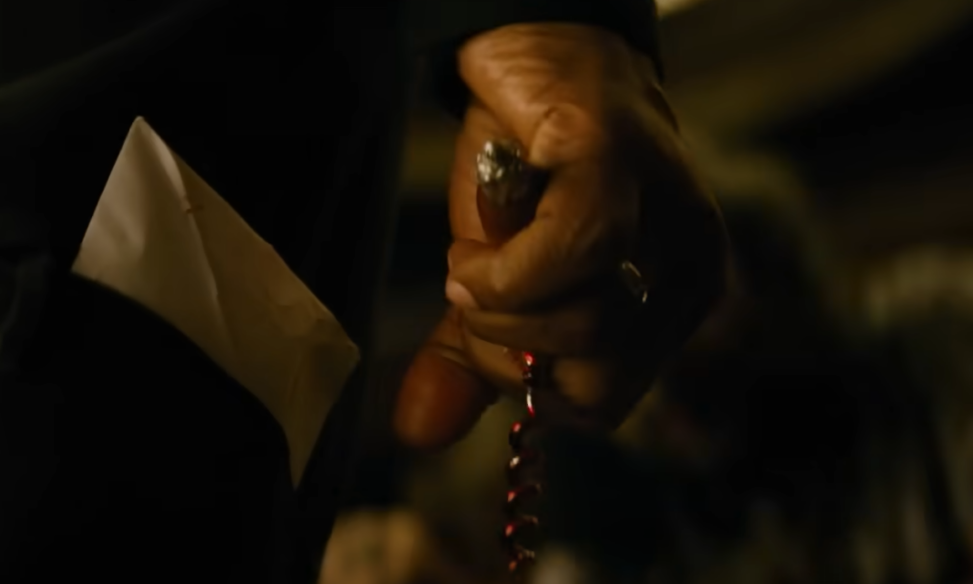In the action-packed film “The Equalizer,” Denzel Washington’s character, Robert McCall, engages in a brutal confrontation with a Russian gang in a confined, claustrophobic office bar. This particular scene captures McCall’s strategic and well thought out approach to combat as he easily takes down multiple Russian gang members within a limited time frame. He uses everything from a shot glass to a corkscrew to subdue these gangsters, resulting in an interesting form of conflict. McCall sets a one-minute timer on his watch before engaging in this brutal bar fight. Once the timer is set, he enters tunnel vision mode. As time slows down, he begins to take down the assailants with ease one by one. He times everything through the entire movie, almost as a nod to his relentless pursuit of perfection and constant attention to detail.
The mise en scène sets the stage for a tense battle within the cramped confines of the bar office. Unlike a typical alleyway setting often seen in Hollywood action films, this scene unfolds in a more unconventional location, adding an element of suspense and creativity; with the dim lighting, intimidating atmosphere, and the head boss at the head of the table and his counter parts surrounding McCall all around the room restricting his space. This adds to the intensity of the fight leaving the viewer with a heightened sense of danger.
The violence depicted in the scene is precise and controlled, reflecting McCall’s brutal fighting style. Rather than relying solely on brute force, he utilizes his surrounding objects to gain the upper hand, turning everyday bar objects into weapons. This strategic approach to combat adds a level of originality to the character and sets him apart from traditional heroes who rely solely on brute force.
Gender representation in this scene does not really differ from typical Hollywood action sequences, as McCall faces off against male members of the Russian gang. Although the fight begins because of a female, the actual fight is very stereotypical male on male violence, as see in most Hollywood films.
The editing and camera work in the scene is crafted to enhance the tension and danger of the situation. Quick cut, close-up shots and slow-motion effects highlight McCall’s precise movements and the severity of each blow, while unique foreshadowing of the weapons keeps the viewer engaged in the action. The use of McCall’s watch as a countdown timer adds an additional layer of suspense, creating a sense of time pressure that drives the pacing of the scene, while also slowing down the entire scene.
Scholarly Analysis:
From Stephen Prince’s exploration of violence in Hollywood films, this scene exemplifies how action sequences can serve as more than just spectacle, but also as a means of character development and narrative progression. McCall’s strategic approach to combat reflects a deeper understanding of his character and motivations, elevating the scene beyond mere violence for its own sake.
Jennifer Friedlander’s analysis of gender representation in action cinema describes how women are often overlooked and underappreciated; as was the case to the women in the Equalizer, which were often frowned upon and shunned by society, while McCall had a rather heroic and knight in shining armor demeanor.
“The Equalizer” achieved some significant success at the box office, grossing over $190 million worldwide, according to Box Office Mojo. Its ruthless and action-packed style was a major hit once it hit theatres back in 2014.
Real-life Consequences:
While the movie is very violent and over the top, the emphasis on strategy, resourcefulness, critical thinking and problem-solving skills add to the originality of the film. This would be a major hit for viewers who enjoy lots of action and well-choreographed fight scenes. As far as real-life consequences, I believe each person has a different level of graphic scenes they can watch before it becomes too extreme, this movie definitely walks the line and should be watched by mature audiences.
In conclusion, the bar fight scene in “The Equalizer” offers a dynamic portrayal of violence within the action genre, showcasing McCall’s brutal fighting abilities.
Bibliography:
Prince, Stephen. Classical Film Violence: Designing and Regulating Brutality in Hollywood Cinema, 1930-1968. Google Books, Rutgers University Press, 2003, books.google.ca/books?hl=en&lr=&id=TAFy6MgekMwC&oi=fnd&pg=PA30&dq=Stephen+Prince%27s+exploration+of+violence+in+Hollywood+films&ots=qtYEh2AQ2u&sig=RBhHoNmxhx5H5VDzaWPKyiB86m0&redir_esc=y#v=onepage&q=Stephen%20Prince. Accessed 26 Mar. 2024.
Friedlander, Jennifer. Feminine Look: Sexuation, Spectatorship, Subversion. Google Books, State University of New York Press, 1 Jan. 2009, books.google.ca/books?hl=en&lr=&id=Ym1ADWLrWmwC&oi=fnd&pg=PR3&dq=Jennifer+Friedlander%27s+analysis+of+gender+representation+in+action+cinema&ots=I3FpjyHWBs&sig=eIB-gtac88adcWOAOwbALwrEylY&redir_esc=y#v=onepage&q=Jennifer%20Friedlander. Accessed 26 Mar. 2024.
“The Equalizer.” Box Office Mojo, www.boxofficemojo.com/title/tt0455944/?ref_=bo_se_r_1.


Collin Peter
The bar fight scene in the movie “The Equalizer” is without a doubt intense and action-packed. However, its portrayal of violence, gender representation, and reliance on cinematic clichés raises several concerns.
McCall’s skillful use of improvised weapons highlights strategic acumen but risks glorifying excessive violence. Such depictions can normalize violence as a conflict resolution method, potentially impacting younger audiences negatively. The exaggerated portrayal of McCall’s combat tactics, like the one-minute timer and “tunnel vision mode,” may seem contrived and unrealistic, detracting from authenticity and character development.
The gender representation in the scene is stereotypical and disappointing. Despite the initial involvement of a female character, the confrontation quickly turns into a male-dominated brawl, perpetuating outdated gender norms and limiting diverse storytelling potential. This undermines the film’s potential to challenge gender roles and offer a nuanced portrayal of conflict.
In addition, although the overall setting effectively builds an atmosphere of tension and claustrophobia, it relies heavily on clichéd elements often seen in Hollywood action movies. The use of dim lighting, confined space, and menacing Russian gangsters feels overused and lacks originality, reducing the impact and creativity of the scene. Although it references Stephen Prince and Jennifer Friedlander, the analysis only briefly touches upon the themes of the scene and does not provide any meaningful insights into its depiction of violence and gender.
“The Equalizer” is entertaining but falls short of depicting violence, gender representation, and originality. More socially aware storytelling could have created a more meaningful experience but overall nice work.